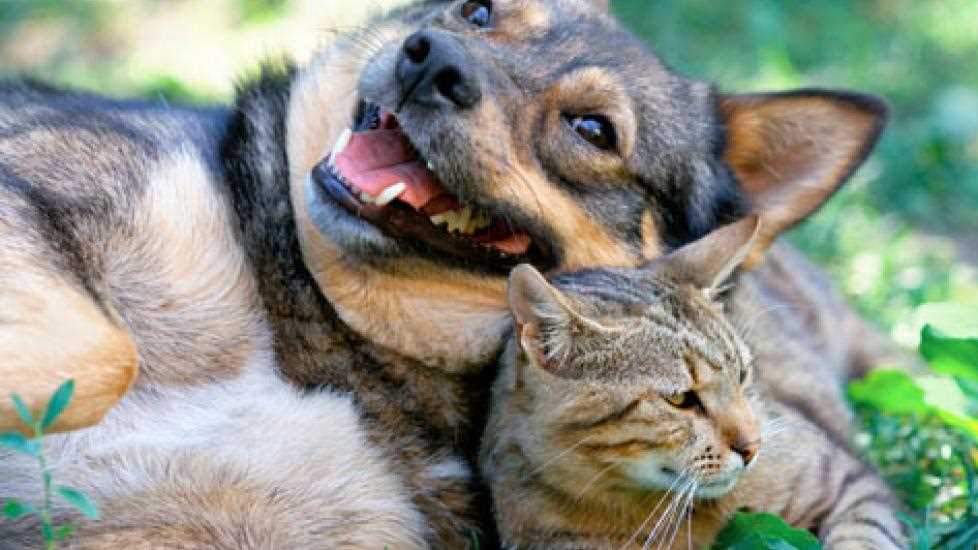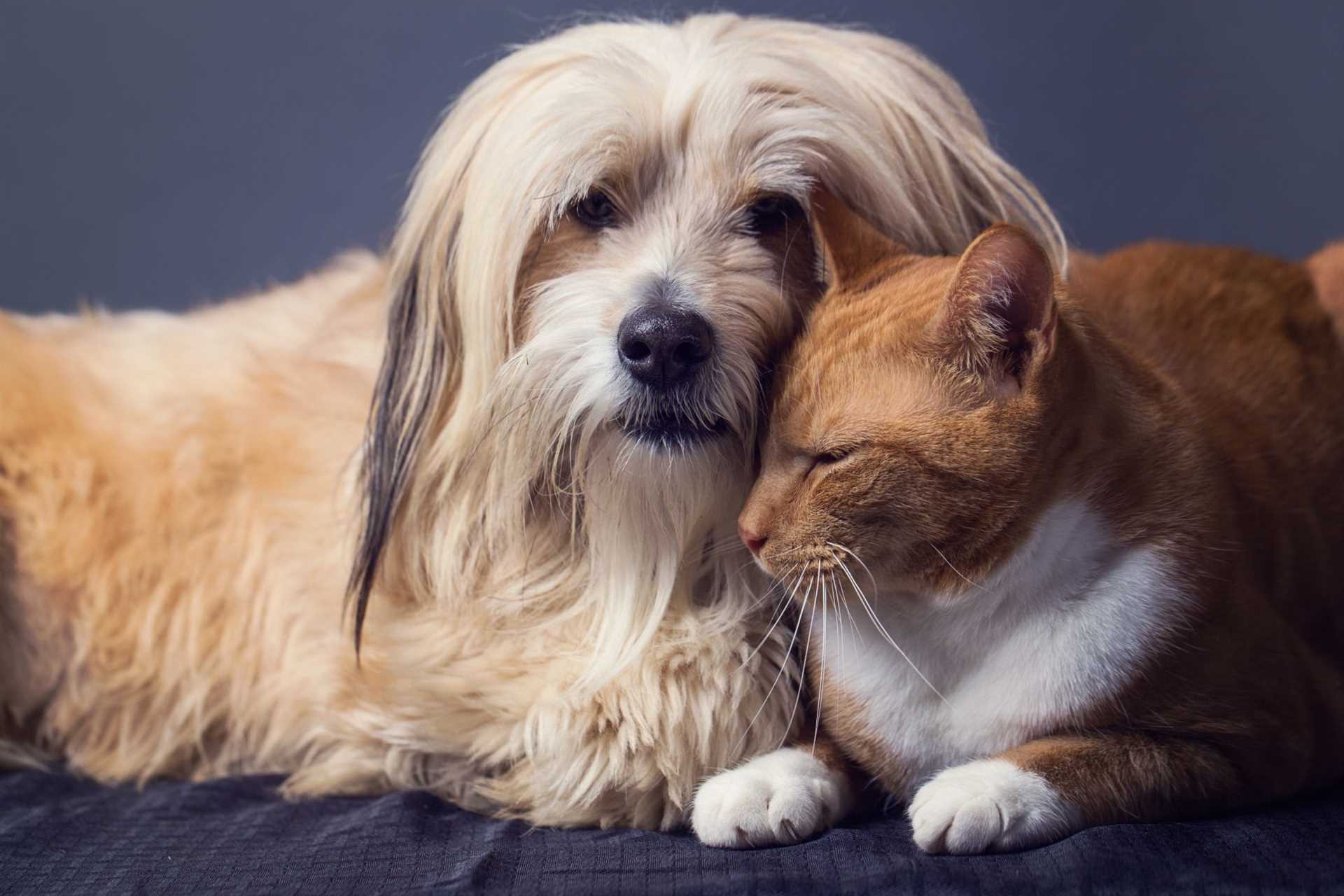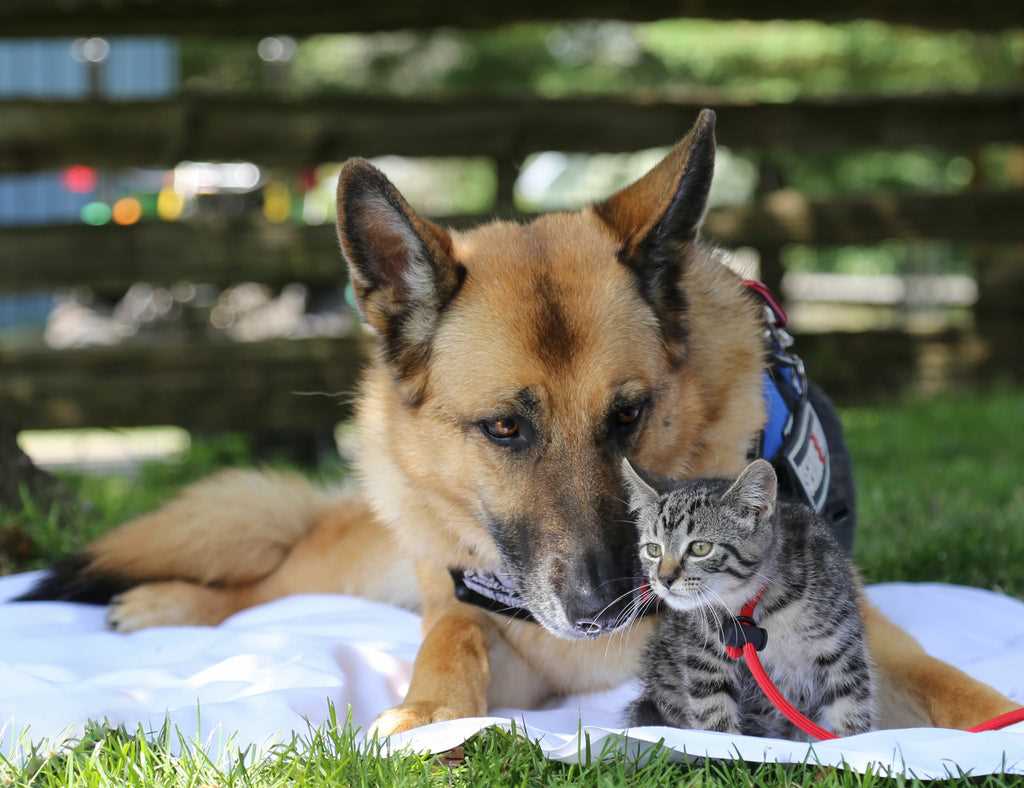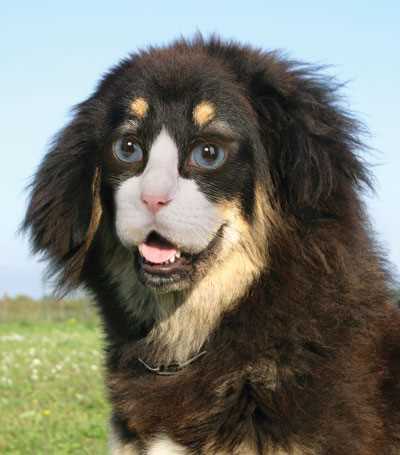It’s a common misconception that these furry companions can create hybrids. In reality, the biological differences between species prevent such unions. Genetic incompatibility is a significant barrier, ensuring that interspecies reproduction remains impossible.
While I see many humans curious about the possibility of mixing traits from different kinds of pets, it’s essential to understand that each species has its unique set of chromosomes. For instance, the genetic makeup of a canine differs significantly from that of a feline, making it biologically unfeasible for them to produce offspring together.
If you’re considering expanding your pet family, focus on adopting similar species for companionship. This ensures not only compatibility in social behaviors but also a more harmonious household. Trust me; as a Scottish Fold, I can say that living with a fellow feline brings much more joy than any imaginary hybrid could!
Can Dogs and Cats Interbreed?

Absolutely not. These two species are genetically distinct, making interbreeding impossible. Their differences extend beyond mere appearance; they belong to separate families in the animal kingdom. While I may share a cozy couch with my canine friend, we cannot produce offspring together.
Genetic incompatibility is the main reason for this. Canines and felines have different numbers of chromosomes–dogs have 78, while felines possess 38. This disparity prevents any viable hybridization from occurring.
While I enjoy a playful chase with my furry dog companion, any notion of creating a mixed-species offspring is purely fictional. Many cartoons or stories might depict such scenarios, but in reality, they are just that: stories. Felines and canines will always remain separate entities in the animal kingdom.
So, if you’re ever wondering about the possibility of a cross-species baby, rest assured that it’s simply not feasible. Instead, appreciate the unique qualities that each species brings to the table–like my elegant purring and my friend’s enthusiastic barking!
Understanding Genetic Compatibility Between Canines and Felines

Genetic factors prevent reproduction between canines and felines. Distinct species barriers arise from their evolutionary paths, which lead to significant differences in chromosomal structures. This incompatibility ensures that even with close interaction, offspring cannot result from their unions.
Chromosomal Differences
- Canines typically possess 78 chromosomes.
- Felines have 38 chromosomes.
- Such differences create genetic mismatches that prohibit fertilization.
Health and Behavioral Implications

Understanding these genetic disparities is crucial for pet owners. Cross-species interactions can lead to stress and behavioral issues. Providing separate spaces and avoiding forced contact can enhance the well-being of both animals.
For those interested in pet safety, it’s essential to be aware of plants that may be harmful. For example, check is tradescantia zebrina toxic to cats for information on potential dangers in your home.
Myths and Misconceptions About Interbreeding Pets

It’s a common misunderstanding that different species can produce offspring. Many believe that mixing my kind with a canine counterpart is feasible. This notion is purely fictional. Genetic barriers prevent these species from creating hybrids, regardless of how closely they seem to coexist.
Another prevalent myth suggests that behavior can influence compatibility. Some think that living together harmoniously might lead to interspecies offspring. However, social interaction does not change the biological limitations set by genetics.
People often wonder about the appearance of potential hybrids. Imagining a creature with traits of both species captivates the imagination. Yet, no scientific evidence supports the idea that such hybrids exist or could exist. This fantasy is simply a product of creative thinking rather than biological reality.
There’s also a belief that domesticated animals have more lenient reproductive rules. The idea that domestication removes natural barriers is misleading. The fundamental genetic incompatibilities remain intact, regardless of how friendly or familiar we might be with one another.
For those curious about the history of my kind, check out this link: how long have cats been on earth. It’s fascinating to see how we’ve evolved over time without intermixing with other species.
Implications of Hybridization on Animal Health
Hybridization between different species can lead to various health concerns that affect the well-being of the offspring. Genetic incompatibilities often result in inherited disorders, which may manifest in both physical and behavioral traits. For instance, mixed-breed animals might experience a higher likelihood of certain genetic diseases common in one parent species.
Research suggests that hybrid animals may inherit vulnerabilities to specific ailments. For example, their immune systems might be less robust due to a lack of genetic diversity, leading to increased susceptibility to infections. This is particularly relevant for conditions like respiratory diseases or skin problems, which can arise from weakened immune responses.
Anomalies in physical development are another risk. Hybrids may exhibit various structural issues, including bone deformities and organ malformations, stemming from incompatible genetic information. These anomalies can significantly impact their quality of life and lead to chronic pain or complications that require medical intervention.
Behavioral problems can also surface in hybrids. Traits from both species might create confusion in social interactions, leading to anxiety or aggression. Proper socialization and training can mitigate these issues, but the underlying genetic factors can pose ongoing challenges.
Regular health screenings and consultations with veterinarians familiar with hybrid conditions are crucial for monitoring and addressing these potential health issues. Ensuring a proper diet and exercise regimen tailored to the hybrid’s needs can also improve overall health and longevity.
It’s a common misconception that these furry companions can create hybrids. In reality, the biological differences between species prevent such unions. Genetic incompatibility is a significant barrier, ensuring that interspecies reproduction remains impossible.
While I see many humans curious about the possibility of mixing traits from different kinds of pets, it’s essential to understand that each species has its unique set of chromosomes. For instance, the genetic makeup of a canine differs significantly from that of a feline, making it biologically unfeasible for them to produce offspring together.
If you’re considering expanding your pet family, focus on adopting similar species for companionship. This ensures not only compatibility in social behaviors but also a more harmonious household. Trust me; as a Scottish Fold, I can say that living with a fellow feline brings much more joy than any imaginary hybrid could!
Can Dogs and Cats Interbreed?

Absolutely not. These two species are genetically distinct, making interbreeding impossible. Their differences extend beyond mere appearance; they belong to separate families in the animal kingdom. While I may share a cozy couch with my canine friend, we cannot produce offspring together.
Genetic incompatibility is the main reason for this. Canines and felines have different numbers of chromosomes–dogs have 78, while felines possess 38. This disparity prevents any viable hybridization from occurring.
While I enjoy a playful chase with my furry dog companion, any notion of creating a mixed-species offspring is purely fictional. Many cartoons or stories might depict such scenarios, but in reality, they are just that: stories. Felines and canines will always remain separate entities in the animal kingdom.
So, if you’re ever wondering about the possibility of a cross-species baby, rest assured that it’s simply not feasible. Instead, appreciate the unique qualities that each species brings to the table–like my elegant purring and my friend’s enthusiastic barking!
Understanding Genetic Compatibility Between Canines and Felines

Genetic factors prevent reproduction between canines and felines. Distinct species barriers arise from their evolutionary paths, which lead to significant differences in chromosomal structures. This incompatibility ensures that even with close interaction, offspring cannot result from their unions.
Chromosomal Differences
- Canines typically possess 78 chromosomes.
- Felines have 38 chromosomes.
- Such differences create genetic mismatches that prohibit fertilization.
Health and Behavioral Implications

Understanding these genetic disparities is crucial for pet owners. Cross-species interactions can lead to stress and behavioral issues. Providing separate spaces and avoiding forced contact can enhance the well-being of both animals.
For those interested in pet safety, it’s essential to be aware of plants that may be harmful. For example, check is tradescantia zebrina toxic to cats for information on potential dangers in your home.
Myths and Misconceptions About Interbreeding Pets

It’s a common misunderstanding that different species can produce offspring. Many believe that mixing my kind with a canine counterpart is feasible. This notion is purely fictional. Genetic barriers prevent these species from creating hybrids, regardless of how closely they seem to coexist.
Another prevalent myth suggests that behavior can influence compatibility. Some think that living together harmoniously might lead to interspecies offspring. However, social interaction does not change the biological limitations set by genetics.
People often wonder about the appearance of potential hybrids. Imagining a creature with traits of both species captivates the imagination. Yet, no scientific evidence supports the idea that such hybrids exist or could exist. This fantasy is simply a product of creative thinking rather than biological reality.
There’s also a belief that domesticated animals have more lenient reproductive rules. The idea that domestication removes natural barriers is misleading. The fundamental genetic incompatibilities remain intact, regardless of how friendly or familiar we might be with one another.
For those curious about the history of my kind, check out this link: how long have cats been on earth. It’s fascinating to see how we’ve evolved over time without intermixing with other species.
Implications of Hybridization on Animal Health
Hybridization between different species can lead to various health concerns that affect the well-being of the offspring. Genetic incompatibilities often result in inherited disorders, which may manifest in both physical and behavioral traits. For instance, mixed-breed animals might experience a higher likelihood of certain genetic diseases common in one parent species.
Research suggests that hybrid animals may inherit vulnerabilities to specific ailments. For example, their immune systems might be less robust due to a lack of genetic diversity, leading to increased susceptibility to infections. This is particularly relevant for conditions like respiratory diseases or skin problems, which can arise from weakened immune responses.
Anomalies in physical development are another risk. Hybrids may exhibit various structural issues, including bone deformities and organ malformations, stemming from incompatible genetic information. These anomalies can significantly impact their quality of life and lead to chronic pain or complications that require medical intervention.
Behavioral problems can also surface in hybrids. Traits from both species might create confusion in social interactions, leading to anxiety or aggression. Proper socialization and training can mitigate these issues, but the underlying genetic factors can pose ongoing challenges.
Regular health screenings and consultations with veterinarians familiar with hybrid conditions are crucial for monitoring and addressing these potential health issues. Ensuring a proper diet and exercise regimen tailored to the hybrid’s needs can also improve overall health and longevity.
It’s a common misconception that these furry companions can create hybrids. In reality, the biological differences between species prevent such unions. Genetic incompatibility is a significant barrier, ensuring that interspecies reproduction remains impossible.
While I see many humans curious about the possibility of mixing traits from different kinds of pets, it’s essential to understand that each species has its unique set of chromosomes. For instance, the genetic makeup of a canine differs significantly from that of a feline, making it biologically unfeasible for them to produce offspring together.
If you’re considering expanding your pet family, focus on adopting similar species for companionship. This ensures not only compatibility in social behaviors but also a more harmonious household. Trust me; as a Scottish Fold, I can say that living with a fellow feline brings much more joy than any imaginary hybrid could!
Can Dogs and Cats Interbreed?

Absolutely not. These two species are genetically distinct, making interbreeding impossible. Their differences extend beyond mere appearance; they belong to separate families in the animal kingdom. While I may share a cozy couch with my canine friend, we cannot produce offspring together.
Genetic incompatibility is the main reason for this. Canines and felines have different numbers of chromosomes–dogs have 78, while felines possess 38. This disparity prevents any viable hybridization from occurring.
While I enjoy a playful chase with my furry dog companion, any notion of creating a mixed-species offspring is purely fictional. Many cartoons or stories might depict such scenarios, but in reality, they are just that: stories. Felines and canines will always remain separate entities in the animal kingdom.
So, if you’re ever wondering about the possibility of a cross-species baby, rest assured that it’s simply not feasible. Instead, appreciate the unique qualities that each species brings to the table–like my elegant purring and my friend’s enthusiastic barking!
Understanding Genetic Compatibility Between Canines and Felines

Genetic factors prevent reproduction between canines and felines. Distinct species barriers arise from their evolutionary paths, which lead to significant differences in chromosomal structures. This incompatibility ensures that even with close interaction, offspring cannot result from their unions.
Chromosomal Differences
- Canines typically possess 78 chromosomes.
- Felines have 38 chromosomes.
- Such differences create genetic mismatches that prohibit fertilization.
Health and Behavioral Implications

Understanding these genetic disparities is crucial for pet owners. Cross-species interactions can lead to stress and behavioral issues. Providing separate spaces and avoiding forced contact can enhance the well-being of both animals.
For those interested in pet safety, it’s essential to be aware of plants that may be harmful. For example, check is tradescantia zebrina toxic to cats for information on potential dangers in your home.
Myths and Misconceptions About Interbreeding Pets

It’s a common misunderstanding that different species can produce offspring. Many believe that mixing my kind with a canine counterpart is feasible. This notion is purely fictional. Genetic barriers prevent these species from creating hybrids, regardless of how closely they seem to coexist.
Another prevalent myth suggests that behavior can influence compatibility. Some think that living together harmoniously might lead to interspecies offspring. However, social interaction does not change the biological limitations set by genetics.
People often wonder about the appearance of potential hybrids. Imagining a creature with traits of both species captivates the imagination. Yet, no scientific evidence supports the idea that such hybrids exist or could exist. This fantasy is simply a product of creative thinking rather than biological reality.
There’s also a belief that domesticated animals have more lenient reproductive rules. The idea that domestication removes natural barriers is misleading. The fundamental genetic incompatibilities remain intact, regardless of how friendly or familiar we might be with one another.
For those curious about the history of my kind, check out this link: how long have cats been on earth. It’s fascinating to see how we’ve evolved over time without intermixing with other species.
Implications of Hybridization on Animal Health
Hybridization between different species can lead to various health concerns that affect the well-being of the offspring. Genetic incompatibilities often result in inherited disorders, which may manifest in both physical and behavioral traits. For instance, mixed-breed animals might experience a higher likelihood of certain genetic diseases common in one parent species.
Research suggests that hybrid animals may inherit vulnerabilities to specific ailments. For example, their immune systems might be less robust due to a lack of genetic diversity, leading to increased susceptibility to infections. This is particularly relevant for conditions like respiratory diseases or skin problems, which can arise from weakened immune responses.
Anomalies in physical development are another risk. Hybrids may exhibit various structural issues, including bone deformities and organ malformations, stemming from incompatible genetic information. These anomalies can significantly impact their quality of life and lead to chronic pain or complications that require medical intervention.
Behavioral problems can also surface in hybrids. Traits from both species might create confusion in social interactions, leading to anxiety or aggression. Proper socialization and training can mitigate these issues, but the underlying genetic factors can pose ongoing challenges.
Regular health screenings and consultations with veterinarians familiar with hybrid conditions are crucial for monitoring and addressing these potential health issues. Ensuring a proper diet and exercise regimen tailored to the hybrid’s needs can also improve overall health and longevity.







